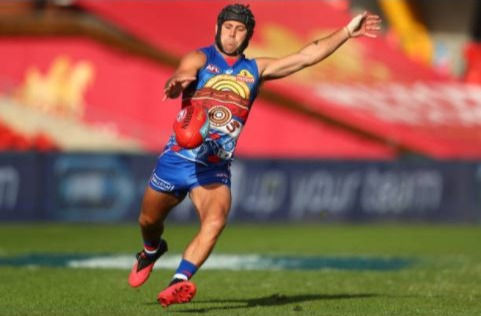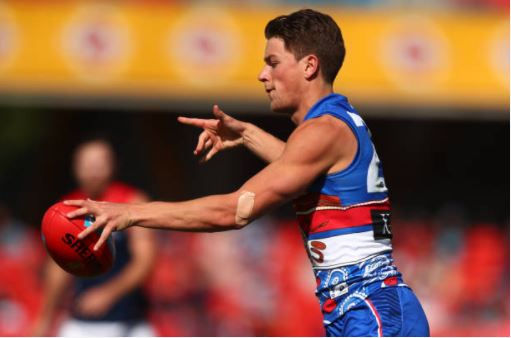5 Things We Learned - Round 13
- Nick Galea

- Aug 25, 2020
- 5 min read
Updated: Nov 7, 2020
In what was a must win game to keep our finals chances alive, the Western Bulldogs returned to the Top Eight with a 28 point victory over the Melbourne Demons, thanks to a blistering six goal third quarter that broke the game open.
With a cluster of sides vying for the bottom half of the eight and the Demons winning their past three games by 50+ points, it wasn’t exactly a huge statement by us but it at least gives us something to properly build off with elements of our best brand of football returning to the scene.
1. The Pressure Game
I mentioned last week about our ability to convert stoppages into scoring opportunities but in recent years the general avenue for scoring has come from turnovers to create a winning score.
Across the game, both sides averaged 186 and 184 pressure ratings points, rated average on the pressure gauge, but it was in the “Premiership Quarter” where we made our mark, increasing our intensity to another level and rose above the challenge before us.
Of our six third quarter goals, five came from a turnover, with four of them starting from inside our defensive 50.
When you factor in that 59 (9.5) of our 80 points came from turnovers, being able to manufacture five goals alone in just the one game breaking quarter was extremely rewarding and satisfying.
This increase of intensity at the contests and around the ground was evidently seen in the first 10 minutes of the third quarter where we kicked three goals in eight minutes, reaching 221 pressure rating points, rating elite; in contrast the Demons 150, rated poor, within the same time-frame.
Come the final siren we outscored the Demons by 36 points from this source and this was one of the major differences in the end.
2. The Defensive 50 battle
When Melbourne replaced Nathan Jones (quad injury) with forward and former Footscray 2016 premiership player Mitch Hannan to join Tom McDonald and Sam Weideman as the taller options, it left Kysaiah Pickett and Charlie Spargo with a lot of responsibility to bring pressure and prevent the ball exiting out of their forward 50 with ease.
Going into the game the Bulldogs were the best ball movement team from the back half in the AFL, ranked number one in the competition for Defensive 50 to Forward 50 transition, moving the ball in that source successfully 27% of the time. In contrast, Melbourne were ranked number one in halting that style of play.
It was that back half burst in the third quarter that set the game apart as our three aggressive half backs in Hayden Crozier, Caleb Daniel, Bailey Williams and Jason Johanissen did as they pleased switching the play made the most of that lack of pressure in the Demons forward half.
Collectively those four combined for 69 possessions, 47 of them being uncontested, 1616 metres gained, but most importantly they had 49 kicks between them by the final siren which is a recipe for disaster.
The Demons inability to pressure or contain the Dogs run off half back proved crucial in our 28 point victory.

Caleb Daniel and the half back crew were at their best in the game breaking third quarter. Source: Getty Images
3. Laitham “The Dutchman” Vandermeer
The ball might move far faster by foot than by run and carry but having a combination of both is a deadly proposition.
Laitham Vandermeer has not gathered a huge amount of the ball this season averaging just the 10.55 possessions per game but for the most part there is a positive impact from these touches and a version of creative chaos that comes with them.
On Saturday afternoon he might have run himself into trouble on more than a few occasions but in a side that lacks line breakers, it is nice to see someone willing to back themselves on the burst to create the play instead of waiting for it. He just needs to recognise the correct moments to do so.
Personally I think he is rather similar to another half back on our list in Brad Lynch in trying to play the game too fast, not realising the amount of time he has but his smarts make up for that issue for now.
It wasn’t Vandermeer’s best game by any means but there is clearly something about this kid and he has put together so far a promising season playing in an unfamiliar position across half forward and the wing.
4. Denying Opposition Strengths
I spoke about momentum a couple weeks back after the Brisbane game and how crucial getting on a run during the game is but sometimes it is just as important as being able to prevent such momentum from occurring at all.
Leading into Saturday’s game, Melbourne had a percentage of 214% in fourth quarters this year, had won nine of its 11 last terms and outscored its opponents by 126 points – ranked No.1.
With us holding a 27 point advantage at the final change and the Demons forced to play a more adventurous game style, conceding a couple of early goals in the fourth quarter might have brought about some nerves.
To our boys credit we were able to restrict the Demons to just the 14 points from 11 inside 50 entries.
Not only that, but since round eight the Demons have conceded an average of 18 points per game in second halves – ranked No.1 defensively. Conversely the Dogs blew that statistic out of proportion in the third and fourth quarters scoring 52 points (8.4).
5. The Unheralded Cog in the Midfield
In a midfield battle featuring names like Bontempelli, Macrae, Hunter, Liberatore and Dunkley against Oliver, Brayshaw, Viney and Petracca it can be easy to forget about the rotation midfielders.
Lipinski might be down in some statistical categories this season and be a bit slow around the ground but he is certainly quick in the football IQ department.
Despite having just the one inside 50, Lipinski was able to be record five score involvements and until the latter stages of the game, had the highest disposal tally of any player to not register a turnover, even though he had the most amount of pressure put on his 17 possessions.
When you consider his seven possessions across the second and third quarters received the most amount of pressure of any player on the ground, to go at 100% efficiency during those quarters highlights an intelligent footballer.
Lipinski might not have the flash or grunt of others, but he is a very neat footballer, whose offensive game is ever improving. Watch out when he figures out the other part of his game.

Patrick Lipinski is going under the radar despite an up and down season for the fourth year Bulldog. Source: Getty Images
siren.







Comments